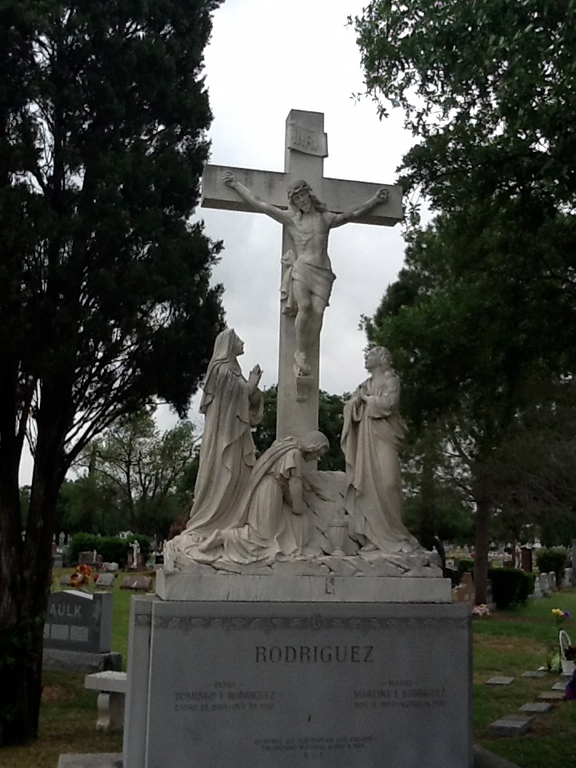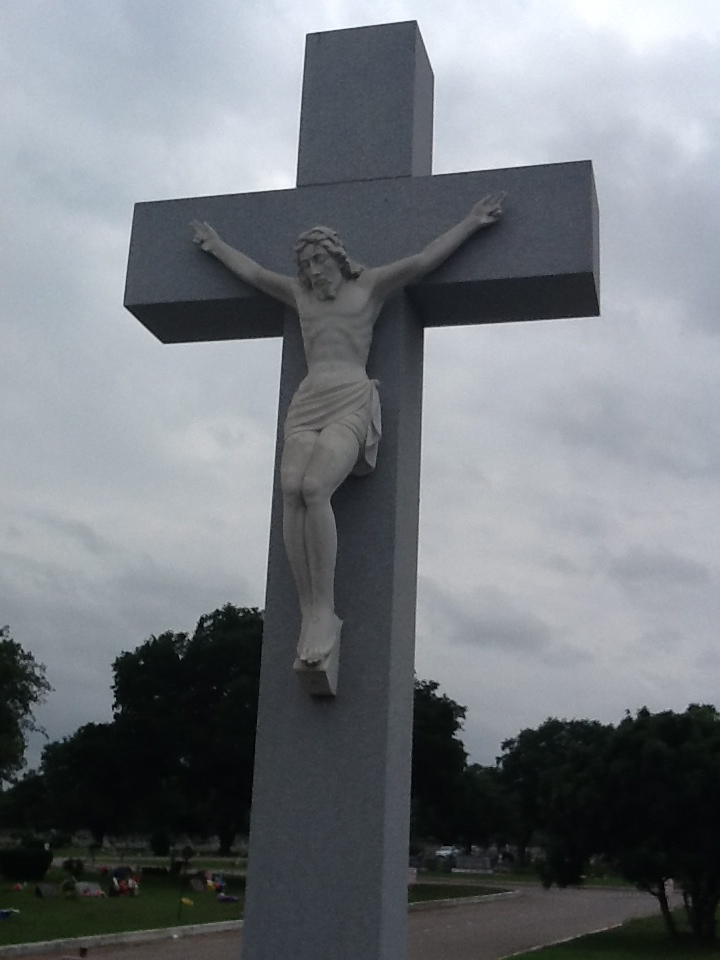| The innate complexities found in crucifixion imagery, in terms of interpreting a triumphant or suffering Christ, begin the discussion on the appellation of an image and identification with a viewer. Rose says of Williamson's methodological approach to semiology, "the viewer creates the meaning of a product by making links between signs. Then, the viewer gives meaning to her - or herself from the product" (134). It is this process which pushes the viewer to meditate on an image of the suffering Christ and possibly see their own tainted reflection in his face. Lipton analyzes, "[the crucifixion image] subtly reminds readers how unappealing they themselves might look to Jesus [...] and highlights the contrast between humans' ungrateful shrinking away from Christ and Christ's unbounded generosity and compassion toward mankind" (1188). Alternatively, viewers may be allowed to see the crucifixion and "draw courage from its very ugliness" (1191).
The undeniable rawness of a body being crucified is bound to create a negative initial reaction of pain or remorse, but the importance of crucifixion imagery "is less sanguine about the immediate effect of the image on the viewer, more wary of the transporting power of the image, more cautious in its aims" (1190-1). Identification with the image requires "combining an actual visual stimulus, a deliberate process of looking, and an imaginative devotional exercise to ignite love for God" (1190). Religious iconography is meant to become a "vehicle for internal contemplation and dialogue" and depending on the experience of the viewer, the image will cause them to react in different ways. Lipton speaks of a sermon written by a pastor to a colony of lepers where through looking at the image of Christ on the cross. He says, "Even scarred and blemished bodies could and should feel love, power, and control over their own souls and actions" (1193). |
|
Separate from those who identify in a specific way with an image based on their own lived experiences, cultural familiarity can also play a strong part in the appellation process. The crucifix found at the "Chapel of Miracles" in San Antonio demonstrates this identity based on a common history. It may be hard to see in the photographs included, but this image has a very distinct artistic style from the others included in this discourse. Christ's face resembles that of a skeleton, that which might be found at a 'dia de los muertos' or 'day of the dead' celebration in Hispanic culture. This identification through cultural familiarity makes a direct appeal to a specific audience. This specific crucifix also possesses significance because of its social modality. This cross was brought to the now San Antonio area in the 1770s when Franciscan monks settled the land. The crucifix then stayed in the San Antonio de Valero mission (commonly known as the Alamo) throughout the Texas revolution and still survives today in the family chapel of the presidio. Rose recognizes, "the play of meanings is constrained by the cultural context in which an image is placed" and "the importance of that context lies both in its shaping of an object's value and in what is done with the visual object" (286). This significance of endurance and survival is a key feature that directly appeals to families that have the same roots as the cross and have also endured through times of trial, both spiritual and political.
It is also evident through the vigil surrounding the crucifix that its duality of cultural and spiritual significance has "allotted considerable space to these powers that provided protection against dangerous death, to the accredited patrons of a particular social group or a particular confraternity, to these personal guardians entrusted with the care of each Christian's body and soul" (Duby 238). This concept of an image speaking to a specific 'confraternity' or social group is also at play in family cemetery plots where religious imagery is placed in order to watch over, protect and represent a specific family or clan, like that of the Rodriguez family's plot at San Fernando cemetery. |
|
|
The anchorage of visual texts in specific locations also effects how meaning is made from in image. Images of the crucified Christ in cemeteries are perfect examples of how an image's anchorage affects its appellation process. The placement of depictions of the crucifixion in cemeteries may seem to add insult to injury, but Worley argues, "the beautiful body of Christ pictures a final perfection that awaits the faithful disciple" (42). And it is through this approach that hope is reawakened within the despair of loss. The attachment of theology to the iconography of the crucifixion allows for key rhetorical themes to appear that would not emerge based simply on semiotics, and one of these rhetorical themes is deliverance. Through images of the Passion, "the depths of divine love for the redemption of the human person - soul and body" are shown. And "these pictures of discipleship [the discipleship of Christ and the discipleship of his followers] train us to see ourselves as more than merely souls awaiting release from the body or bodies burdened by the demands of the soul. They redefine our shallow notions of perfection and enrich our hope for the complete deliverance that God has promised in Christ" (43). Upon entering San Fernando cemetery in San Antonio, one is greeted by an image of a crucifix at the gates of the cemetery. This is a preliminary reminder to all who enter that it is only in death that there is life, as well as serve as a "reminder of the momentary nature of this life's trials in light of eternal glory with Christ, not as a mode of flippant escapism, but as a reliable means of facing the challenges and difficulties that presently beset us" (42). The cemetery images of the crucifix, primarily made of marble and stone, present a steadfast nature to that theme of ultimate deliverance. |
| ||||
|
Saunders, who studies the importance of crucifixes as material manifestations of memory and hope notes, "memory, experience, and identity were often embedded in cruciform imagery" (17). For those who grew up in the Catholic tradition, the crucifix is not a foreign image, and it is because of this prevalence that it can hold multiple meanings within multiple contexts, based on previous encounters and the lived experiences of the viewer. Viewers succumb to "the historical and emotional meanings which they have accumulated over the years have the power to trigger new embodied actions and gestures through which the past is re-enacted in the present - and which transforms them again in the process" (17).
But while there are variations of ultimate, perceived meaning, a common theology surrounding the imagery of the crucifixion also allows a certain level of certainty within the context of diverse approaches to the audiencing of the image. Lipton maintains, "a theological conception of Christ as a loving and compassionate God-man may be an indispensable prerequisite for seeing the image of Jesus" (1201). This rhetorical theme of the enduring love of Christ is consistent whether you are a leper seeking the courage to see "their disease not as a hindrance but as a spiritual opportunity" in the face of physical and social agonies, or whether the viewer is faced with coping with the "guilt at their initial aversion [to the suffering image of Christ, which] brings them to a shared recognition of their own unworthiness and blemish, and sets them on the path toward contrition" (1192,1188). These opposite readings rest in consistent initial theology, which is what allows multiple readings of crucifixes Diverse points of entry into the meaning-making process, whether it be caused by varied cultural or experiential attachment to an image, allow for individual identification with imagery, while still remaining grounded in a similar, basic theology. |
| Complexity in the Cross |
|
Intercalibration and Tangibility |



